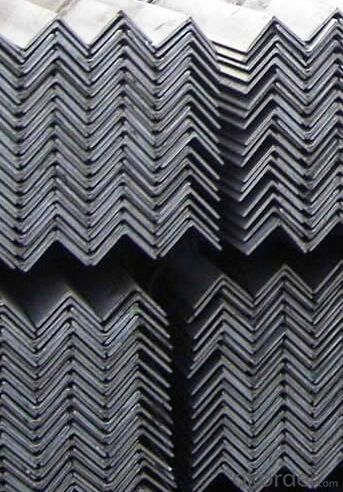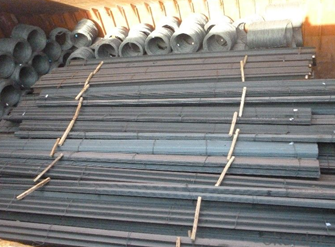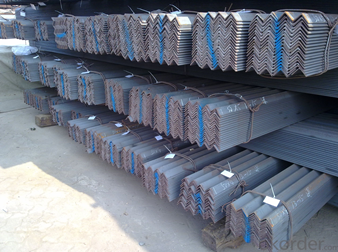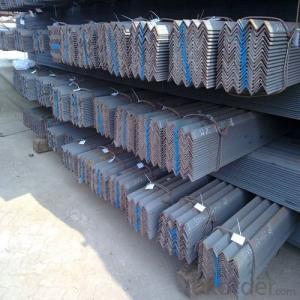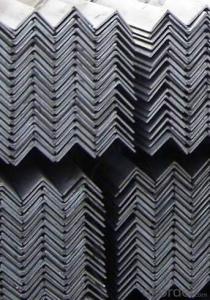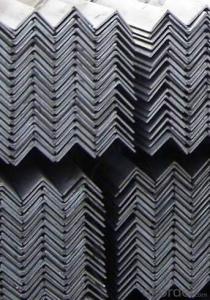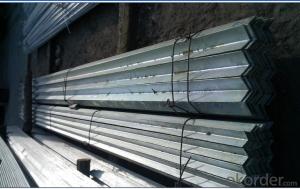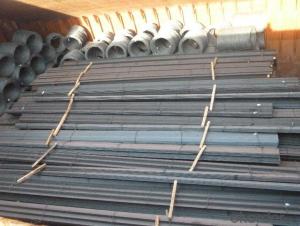HIGH QUALITY GB STANDARD HOT ROLLED ANGLE REBAR
- Loading Port:
- Tianjin
- Payment Terms:
- TT OR LC
- Min Order Qty:
- 50 m.t.
- Supply Capability:
- 5000 m.t./month
OKorder Service Pledge
OKorder Financial Service
You Might Also Like
Product Description:
Specifications of Hot Rolled Steel Rebar:
The production process of Steel Rebar
1-Waling beam furnace 2-Roughing rolling group 3-Intermediate rolling train
4-Finishing rolling group 5-Water-cooling device 6-Walking beam cooler
7-Finishing equipment(including the cold scale shear,short feet collection system,
automatic counting device,bundling machine, collect bench)
Usage and Applications of Hot Rolled Steel Rebar:
Deformed bar is widely used in buildings, bridges, roads and other engineering construction. Big to highways, railways, bridges, culverts, tunnels, public facilities such as flood control, dam, small to housing construction, beam, column, wall and the foundation of the plate, deformed bar is an integral structure material. With the development of world economy and the vigorous development of infrastructure construction, real estate, the demand for deformed bar will be larger and larger..
Packaging & Delivery of Hot Rolled Steel Rebar:
Packaging Detail: products are packed in bundle and then shipped by container or bulk vessel, deformed bar is usually naked strapping delivery, when storing, please pay attention to moisture proof. The performance of rust will produce adverse effect.
Each bundle weight: 2-3MT, or as required
Payment terms: TT payment in advance or Irrevocable LC at sight.
Trade terms :FOB, CFR, CIF
Label:to be specified by customer, generally, each bundle has 1-2 labels
Note:
1. Our products are produced according to national standard (GB), if not, supply according to national standards (GB) or agreement as customer required.
2. Other Grade and Standard Deformed Steel Bar we can supply:
Q235
The Minimum Order Quantity of these products is high, and need to be confirmed.
3. We can not only supply Deformed Steel Bar; if you need anything about building materials, please contact us for further information.
4. Please send us your detail specifications when inquire. We will reply to you as soon as possible. We sincerely hope we can establish a long stable business relationship.
- Q: How do you connect steel angles together?
- Steel angles can be connected together by various methods such as welding, bolting, or using steel angle brackets.
- Q: How do you transport steel angles safely?
- Proper planning and adherence to specific guidelines are necessary for the safe transportation of steel angles. To ensure their safe transport, the following steps should be taken: 1. Secure the steel angles: Before transportation, it is important to securely fasten the steel angles. This can be achieved by using straps or chains to hold them firmly in place. Avoid any movement or shifting of the angles during transit by ensuring they are tightly secured. 2. Choose appropriate transportation equipment: Depending on the quantity and size of the steel angles, select suitable transportation equipment. Flatbed trucks or trailers with secure tie-down points are commonly used for this purpose. If needed, specialized equipment such as cranes or forklifts can be utilized for safe loading and unloading. 3. Safeguard the steel angles: To prevent damage during transit, it is crucial to protect the steel angles from potential hazards. This can be done by using adequate packaging materials like cardboard or wooden crates to cover and provide additional support. Additionally, consider using protective padding or blankets to prevent scratches or dents. 4. Ensure proper weight distribution: Maintaining proper weight distribution is essential for stability during transportation. Distribute the load evenly across the transportation equipment to avoid imbalance or tipping. If necessary, consult weight distribution guidelines or seek professional advice to ensure safe transportation. 5. Adhere to local regulations: Familiarize yourself with the transportation regulations and guidelines in your area. Ensure compliance with any specific requirements regarding load securing, maximum weight limits, or permits for oversized shipments. This will guarantee legal compliance and safe transportation. 6. Inspect and maintain the transportation equipment: Regularly inspect the transportation equipment for any signs of wear and tear. Check the condition of straps, chains, or tie-down points to ensure they are in good working condition. Proper maintenance of the equipment reduces the risk of accidents or incidents during transportation. 7. Plan the route and consider weather conditions: Before transporting the steel angles, carefully plan the route, taking into account any potential obstacles or road conditions that may affect safety. Be aware of height or weight restrictions on certain roads or bridges. Additionally, consider weather conditions such as heavy rain, snow, or strong winds, and adjust the transportation plan accordingly. By following these steps and taking necessary precautions, you can safely transport steel angles, minimizing the risk of damage, accidents, or injuries. Always prioritize safety and comply with applicable regulations for a successful transportation process.
- Q: Are there any limitations on the length-to-thickness ratio of steel angles?
- Steel angles have limitations on their length-to-thickness ratio, which is also known as the slenderness ratio. This ratio is crucial in determining the structural stability and load-bearing capacity of steel angles. To calculate the slenderness ratio, divide the angle's length by its thickness. In general, steel angles with a higher length-to-thickness ratio are more prone to buckling or failure when subjected to compressive loads. To maintain structural integrity, there are industry standards and guidelines that define the maximum slenderness ratios for steel angles. The specific limitations on the length-to-thickness ratio of steel angles vary based on factors such as the steel type, angle cross-sectional shape, applied load, and intended use. These limitations are typically outlined in engineering codes and standards like the American Institute of Steel Construction (AISC) or Eurocode, which provide design guidelines for various structural components, including steel angles. Adhering to these limitations is crucial to prevent structural failures and ensure the safety and performance of steel angles in different applications. Structural engineers and designers should consult the relevant codes and standards to determine the appropriate length-to-thickness ratio for specific steel angle designs.
- Q: Can steel angles be used for pedestrian bridges or walkways?
- Yes, steel angles can be used for pedestrian bridges or walkways. Steel angles are commonly used in construction due to their strength, durability, and versatility. They can be easily fabricated and welded to create the desired structural elements for bridges and walkways. Steel angles provide excellent load-bearing capabilities, making them suitable for supporting pedestrian traffic. Additionally, the corrosion-resistant properties of steel make it an ideal choice for outdoor applications where exposure to weather elements is a concern. Overall, steel angles are a popular choice for pedestrian bridges and walkways due to their reliability and ability to meet the necessary structural requirements.
- Q: What are the different types of steel angles used in automotive manufacturing?
- Automotive manufacturing relies on a variety of steel angles that play a crucial role in designing and constructing automotive structures and parts. Some of the commonly utilized steel angles in this industry include: 1. Equal Angle: This type of steel angle consists of sides of equal length, forming a 90-degree angle. In automotive manufacturing, equal angles find applications in chassis frames, suspension components, and brackets. 2. Unequal Angle: As the name suggests, unequal angles have sides of unequal lengths, creating a 90-degree angle. Automotive manufacturers employ unequal angles to fabricate components with specific dimensions and angles, such as door frames, body reinforcements, and support structures. 3. L Angle: Also known as angle irons, L angles possess two sides of equal length that form a 90-degree angle. They are extensively used in automotive manufacturing for various purposes, including reinforcing panels, mounting brackets, and structural supports. 4. T Angle: Resembling the shape of the letter "T," T angles consist of one long side and one short side forming a 90-degree angle. In automotive manufacturing, T angles play a significant role in joining different components like body panels, fenders, and roof structures. 5. C Angle: Referred to as channel angles, C angles have a C-shaped cross-section. These angles offer structural strength and rigidity, making them suitable for applications such as frame rails, roll cages, and support beams in automotive manufacturing. 6. Z Angle: Z angles feature a Z-shaped cross-section, resembling the letter "Z." They are commonly employed in automotive manufacturing to join and reinforce components like door frames, roof structures, and body reinforcements. These examples merely scratch the surface of the numerous types of steel angles employed in automotive manufacturing. Each type serves a specific purpose and possesses unique properties, such as strength, stability, and flexibility, to meet the diverse requirements of automotive applications.
- Q: What are the typical lead times for steel angle orders?
- The typical lead times for steel angle orders can vary depending on the supplier and factors such as quantity, customization, and current demand. However, lead times generally range from a few days to a few weeks. It is recommended to check with the specific supplier for accurate information on lead times.
- Q: Can steel angles be used for manufacturing machinery?
- Yes, steel angles can be used for manufacturing machinery. Steel angles provide structural support and can be used as framing members, braces, or brackets in machinery construction. They offer high strength, durability, and versatility, making them suitable for various industrial applications.
- Q: Can steel angles be used for framing windows or doors?
- Framing windows or doors is indeed possible with steel angles. In construction, steel angles are widely employed for their robustness and endurance. As framing material, they offer essential support and stability. Moreover, steel angles can be easily tailored and trimmed to the desired length, rendering them suitable for framing windows and doors of different dimensions. Furthermore, by welding or bolting steel angles together, a robust frame can be fashioned capable of enduring substantial loads and furnishing the indispensable support for windows and doors.
- Q: Are steel angles resistant to UV radiation?
- Steel angles are not inherently resistant to UV radiation. However, they can be made more resistant through proper surface treatments or coatings such as paint or galvanization.
- Q: What are the common defects or issues found in steel angles?
- Steel angles can experience various defects or issues that impact their structural integrity and performance. The most common ones include: 1. Surface imperfections: Scratches, pits, or uneven coating may be present on steel angles. While these may not affect the angle's strength significantly, they can impact its appearance and corrosion resistance. 2. Warping: Steel angles can bend or distort along their length, either during manufacturing or as a result of improper handling or storage. Warped angles may not fit properly in applications that require precise dimensions. 3. Dimension flaws: Steel angles should adhere to specific dimensions and tolerances. However, defects like undersized or oversized legs, unequal lengths, or inconsistent thickness can occur. These flaws can cause installation issues or compromise the angle's structural integrity. 4. Lack of straightness: Steel angles should be straight along their entire length to ensure proper alignment and load distribution. However, they can sometimes exhibit a lack of straightness, known as bowing or crooking. This defect makes it difficult to accurately align angles and may result in uneven stress distribution. 5. Internal cracks: Cracks inside the steel angle are a major concern as they weaken its strength and load-bearing capacity. These cracks can occur during manufacturing due to improper cooling or quenching processes, or they can be a result of excessive stress or corrosion. Internal cracks are often invisible to the naked eye, necessitating non-destructive testing methods like ultrasound or magnetic particle inspection. 6. Corrosion: Steel angles are prone to corrosion, particularly in high humidity or chemical exposure environments. Corrosion weakens the structure and affects the angle's performance. Regular maintenance and appropriate protective measures are necessary to prevent or minimize corrosion-related defects. Prompt identification and addressing of these defects or issues are crucial to ensuring the safety and reliability of steel angles in various applications. Regular quality checks, adherence to industry standards, and proper maintenance practices help mitigate these problems and ensure the durability of steel angles.
Send your message to us
HIGH QUALITY GB STANDARD HOT ROLLED ANGLE REBAR
- Loading Port:
- Tianjin
- Payment Terms:
- TT OR LC
- Min Order Qty:
- 50 m.t.
- Supply Capability:
- 5000 m.t./month
OKorder Service Pledge
OKorder Financial Service
Similar products
Hot products
Hot Searches
Related keywords



